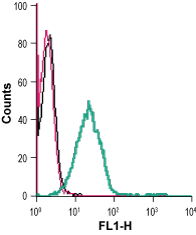Overview
- Peptide (C)EITVANGTAELLEH, corresponding to amino acid residues 191-204 of mouse SVCT2 (Accession Q9EPR4). 2nd extracellular loop.

 Western blot analysis of mouse (lanes 1 and 3) and rat (lanes 2 and 4) brain lysates:1,2. Anti-SVCT2/SLC23A2 (extracellular) Antibody (#AST-022), (1:200).
Western blot analysis of mouse (lanes 1 and 3) and rat (lanes 2 and 4) brain lysates:1,2. Anti-SVCT2/SLC23A2 (extracellular) Antibody (#AST-022), (1:200).
3,4. Anti-SVCT2/SLC23A2 (extracellular) Antibody, preincubated with SVCT2/SLC23A2 (extracellular) Blocking Peptide (#BLP-ST022). Western blot analysis of human MCF-7 breast adenocarcinoma (lanes 1 and 3) and human COLO 205 colon adenocarcinoma (lanes 2 and 4) cell line lysates:1,2. Anti-SVCT2/SLC23A2 (extracellular) Antibody (#AST-022), (1:200).
Western blot analysis of human MCF-7 breast adenocarcinoma (lanes 1 and 3) and human COLO 205 colon adenocarcinoma (lanes 2 and 4) cell line lysates:1,2. Anti-SVCT2/SLC23A2 (extracellular) Antibody (#AST-022), (1:200).
3,4. Anti-SVCT2/SLC23A2 (extracellular) Antibody, preincubated with SVCT2/SLC23A2 (extracellular) Blocking Peptide (#BLP-ST022).
 Expression of SVCT2 in mouse hippocampusImmunohistochemical staining of perfusion-fixed frozen mouse brain sections with Anti-SVCT2/SLC23A2 (extracellular) Antibody (#AST-022), (1:200), followed by goat anti-rabbit-AlexaFluor-488. SVCT2 staining (green) in CA1 hippocampal region is detected in axonal processes (arrows), with the highest density surrounding the pyramidal layer (P). Cell nuclei are stained with DAPI (blue).
Expression of SVCT2 in mouse hippocampusImmunohistochemical staining of perfusion-fixed frozen mouse brain sections with Anti-SVCT2/SLC23A2 (extracellular) Antibody (#AST-022), (1:200), followed by goat anti-rabbit-AlexaFluor-488. SVCT2 staining (green) in CA1 hippocampal region is detected in axonal processes (arrows), with the highest density surrounding the pyramidal layer (P). Cell nuclei are stained with DAPI (blue).
- Bürzle, M. et al. (2013) Mol. Aspects Med. 34, 436.
- Yu, X. et al. (2017) Cell Res. 27, 1020.
- May, J.M. (2012) Subcell. Biochem. 56, 85.
Vitamin C, or ascorbic acid, is an important antioxidant. It also participates in numerous cellular functions such as peptide amidation, myelin formation, synaptic potentiation, and protection against glutamate toxicity. Although it circulates in the plasma in micromolar concentrations, it reaches millimolar concentrations in most tissues. These high concentrations are thought to be generated and maintained by SVCT2, a Na+-dependent transporter1.
SVCT2 belongs to the SLC23 family of nucleobase-ascorbate transporters (NAT), that consists of SLCT1, SLCT2 and SLCT3 transporters2. The NAT family shares a structure that contains fourteen transmembrane segments that are organized into a pair of “7 + 7” inverted repeats. The intertwined repeats constitute two distinctive domains, namely the core domain and the gate domain2.
Neurons in the central nervous system (CNS) contain some of the highest ascorbic acid concentrations in mammalian tissues, and therefore targeted deletion of SVCT2 in mice causes widespread cerebral hemorrhage and death on post-natal day one. SCVT2 is also related to neurodegenerative diseases such as Alzheimer’s, Parkinson’s, and Huntington’s. The expression of SVCT2 is relatively widespread, where it serves to either deliver ascorbic acid to tissues with high demand of vitamin C for enzymatic reactions or to protect metabolically highly active cells or protect specialized tissues from oxidative stress3.
Application key:
Species reactivity key:
Anti-SVCT2/SLC23A2 (extracellular) Antibody (#AST-022) is a highly specific antibody directed against an epitope of the mouse protein. The antibody can be used in western blot and indirect live cell flow cytometry applications. It has been designed to recognize SVCT2 from rat, mouse, and human samples.

